Analysis of IT/IS Strategy for Woolworths: 2017 Report
VerifiedAdded on 2020/03/02
|8
|1947
|57
Report
AI Summary
This report provides a detailed analysis of the strategic management and information system for Woolworths, focusing on the implementation of a new operating model capable of advanced analytics and merchandizing systems to resolve supplier issues. The report explores IT/IS strategy, factors influencing strategic decisions, and the application of Porter's five forces model to assess the competitive landscape. It discusses the pros and cons of IT/IS strategic decisions, the role of IT in Woolworths, and the impact of new management decisions. The analysis includes a stakeholder analysis, functional requirements of the project, and a conclusion summarizing the findings. The report also references various sources to support the analysis, highlighting the importance of information systems in modern business operations and supply chain management.
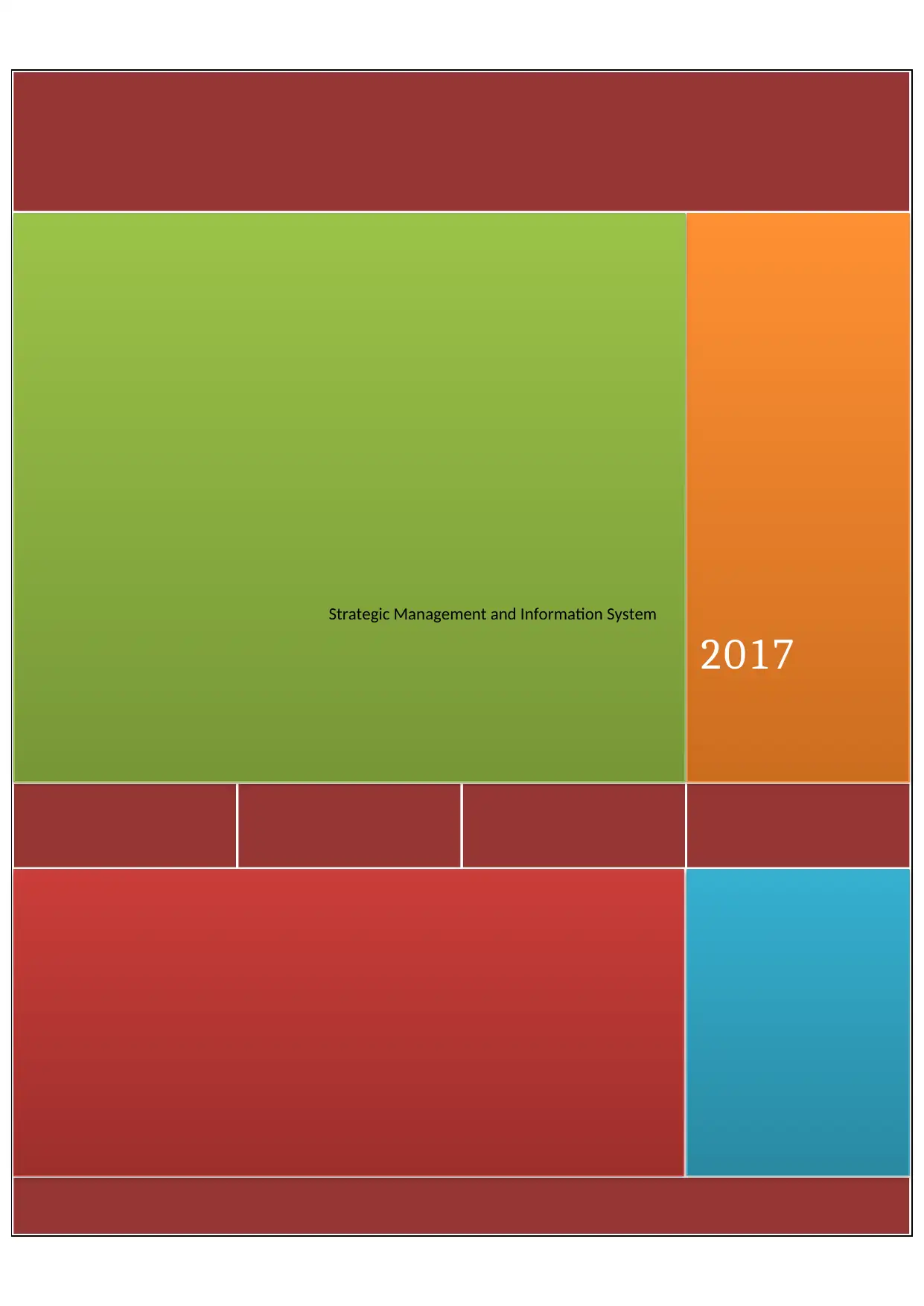
Strategic Management and Information System
2017
2017
Paraphrase This Document
Need a fresh take? Get an instant paraphrase of this document with our AI Paraphraser
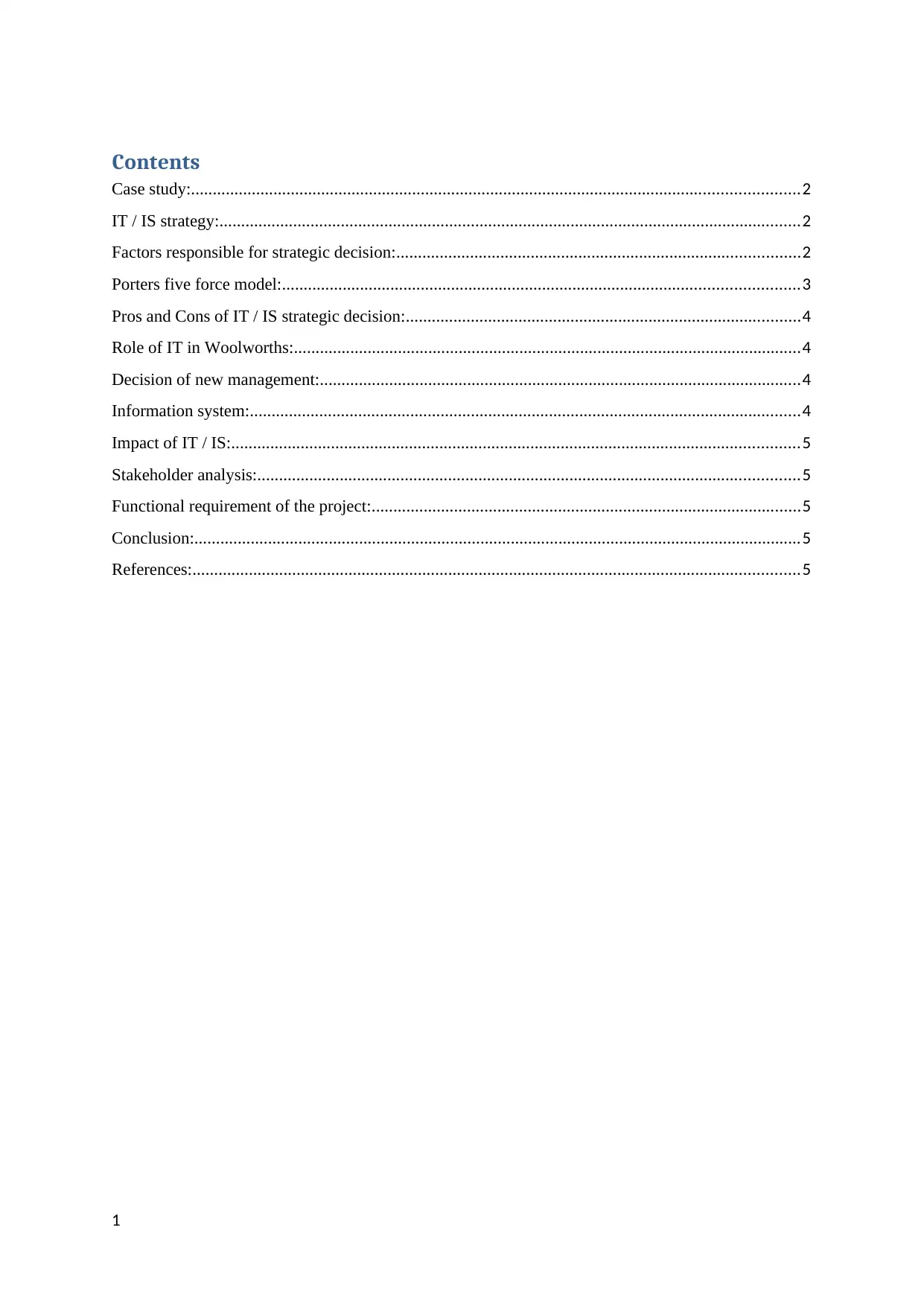
Contents
Case study:............................................................................................................................................2
IT / IS strategy:......................................................................................................................................2
Factors responsible for strategic decision:.............................................................................................2
Porters five force model:.......................................................................................................................3
Pros and Cons of IT / IS strategic decision:...........................................................................................4
Role of IT in Woolworths:.....................................................................................................................4
Decision of new management:...............................................................................................................4
Information system:...............................................................................................................................4
Impact of IT / IS:...................................................................................................................................5
Stakeholder analysis:.............................................................................................................................5
Functional requirement of the project:...................................................................................................5
Conclusion:............................................................................................................................................5
References:............................................................................................................................................5
1
Case study:............................................................................................................................................2
IT / IS strategy:......................................................................................................................................2
Factors responsible for strategic decision:.............................................................................................2
Porters five force model:.......................................................................................................................3
Pros and Cons of IT / IS strategic decision:...........................................................................................4
Role of IT in Woolworths:.....................................................................................................................4
Decision of new management:...............................................................................................................4
Information system:...............................................................................................................................4
Impact of IT / IS:...................................................................................................................................5
Stakeholder analysis:.............................................................................................................................5
Functional requirement of the project:...................................................................................................5
Conclusion:............................................................................................................................................5
References:............................................................................................................................................5
1
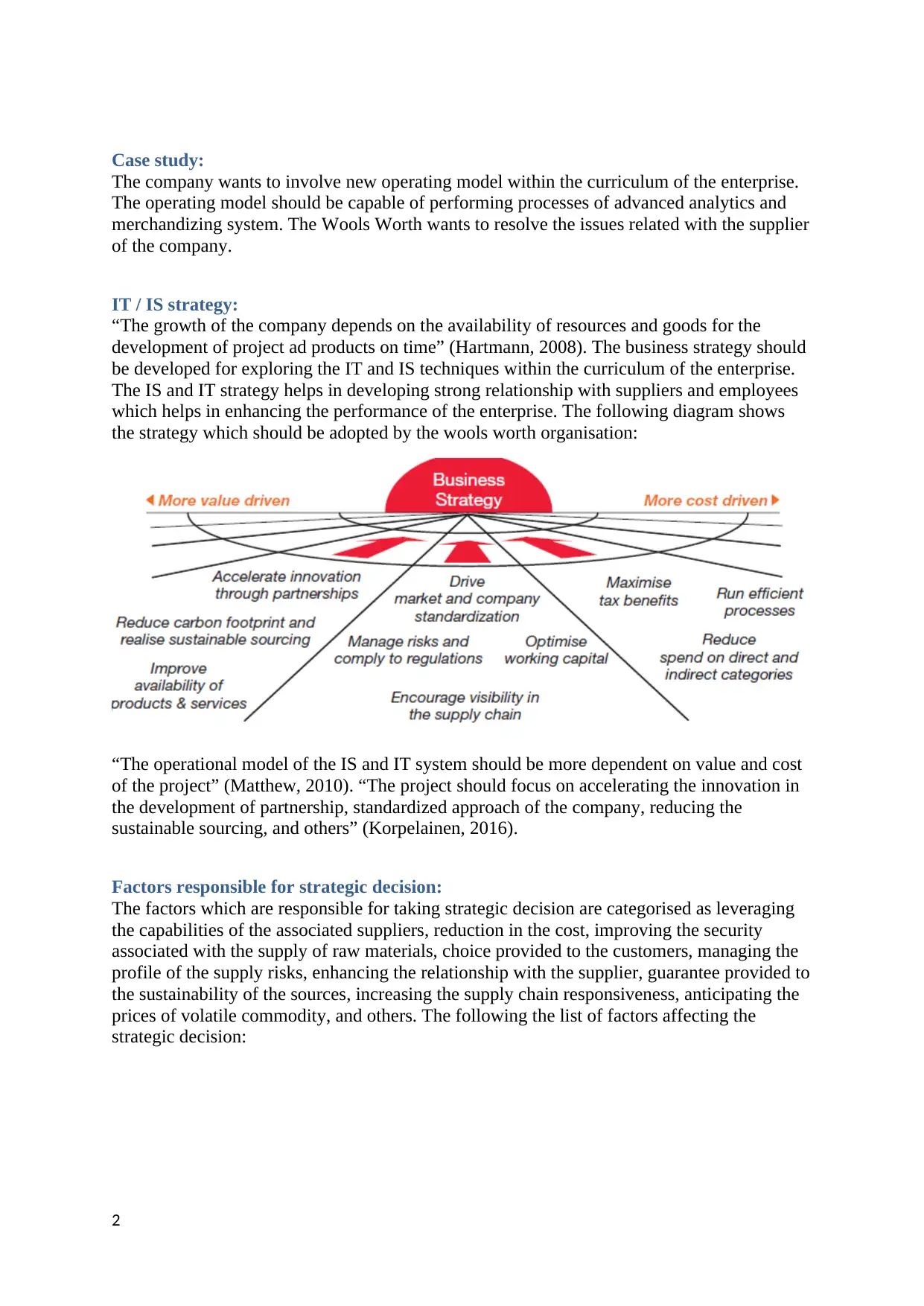
Case study:
The company wants to involve new operating model within the curriculum of the enterprise.
The operating model should be capable of performing processes of advanced analytics and
merchandizing system. The Wools Worth wants to resolve the issues related with the supplier
of the company.
IT / IS strategy:
“The growth of the company depends on the availability of resources and goods for the
development of project ad products on time” (Hartmann, 2008). The business strategy should
be developed for exploring the IT and IS techniques within the curriculum of the enterprise.
The IS and IT strategy helps in developing strong relationship with suppliers and employees
which helps in enhancing the performance of the enterprise. The following diagram shows
the strategy which should be adopted by the wools worth organisation:
“The operational model of the IS and IT system should be more dependent on value and cost
of the project” (Matthew, 2010). “The project should focus on accelerating the innovation in
the development of partnership, standardized approach of the company, reducing the
sustainable sourcing, and others” (Korpelainen, 2016).
Factors responsible for strategic decision:
The factors which are responsible for taking strategic decision are categorised as leveraging
the capabilities of the associated suppliers, reduction in the cost, improving the security
associated with the supply of raw materials, choice provided to the customers, managing the
profile of the supply risks, enhancing the relationship with the supplier, guarantee provided to
the sustainability of the sources, increasing the supply chain responsiveness, anticipating the
prices of volatile commodity, and others. The following the list of factors affecting the
strategic decision:
2
The company wants to involve new operating model within the curriculum of the enterprise.
The operating model should be capable of performing processes of advanced analytics and
merchandizing system. The Wools Worth wants to resolve the issues related with the supplier
of the company.
IT / IS strategy:
“The growth of the company depends on the availability of resources and goods for the
development of project ad products on time” (Hartmann, 2008). The business strategy should
be developed for exploring the IT and IS techniques within the curriculum of the enterprise.
The IS and IT strategy helps in developing strong relationship with suppliers and employees
which helps in enhancing the performance of the enterprise. The following diagram shows
the strategy which should be adopted by the wools worth organisation:
“The operational model of the IS and IT system should be more dependent on value and cost
of the project” (Matthew, 2010). “The project should focus on accelerating the innovation in
the development of partnership, standardized approach of the company, reducing the
sustainable sourcing, and others” (Korpelainen, 2016).
Factors responsible for strategic decision:
The factors which are responsible for taking strategic decision are categorised as leveraging
the capabilities of the associated suppliers, reduction in the cost, improving the security
associated with the supply of raw materials, choice provided to the customers, managing the
profile of the supply risks, enhancing the relationship with the supplier, guarantee provided to
the sustainability of the sources, increasing the supply chain responsiveness, anticipating the
prices of volatile commodity, and others. The following the list of factors affecting the
strategic decision:
2
⊘ This is a preview!⊘
Do you want full access?
Subscribe today to unlock all pages.

Trusted by 1+ million students worldwide
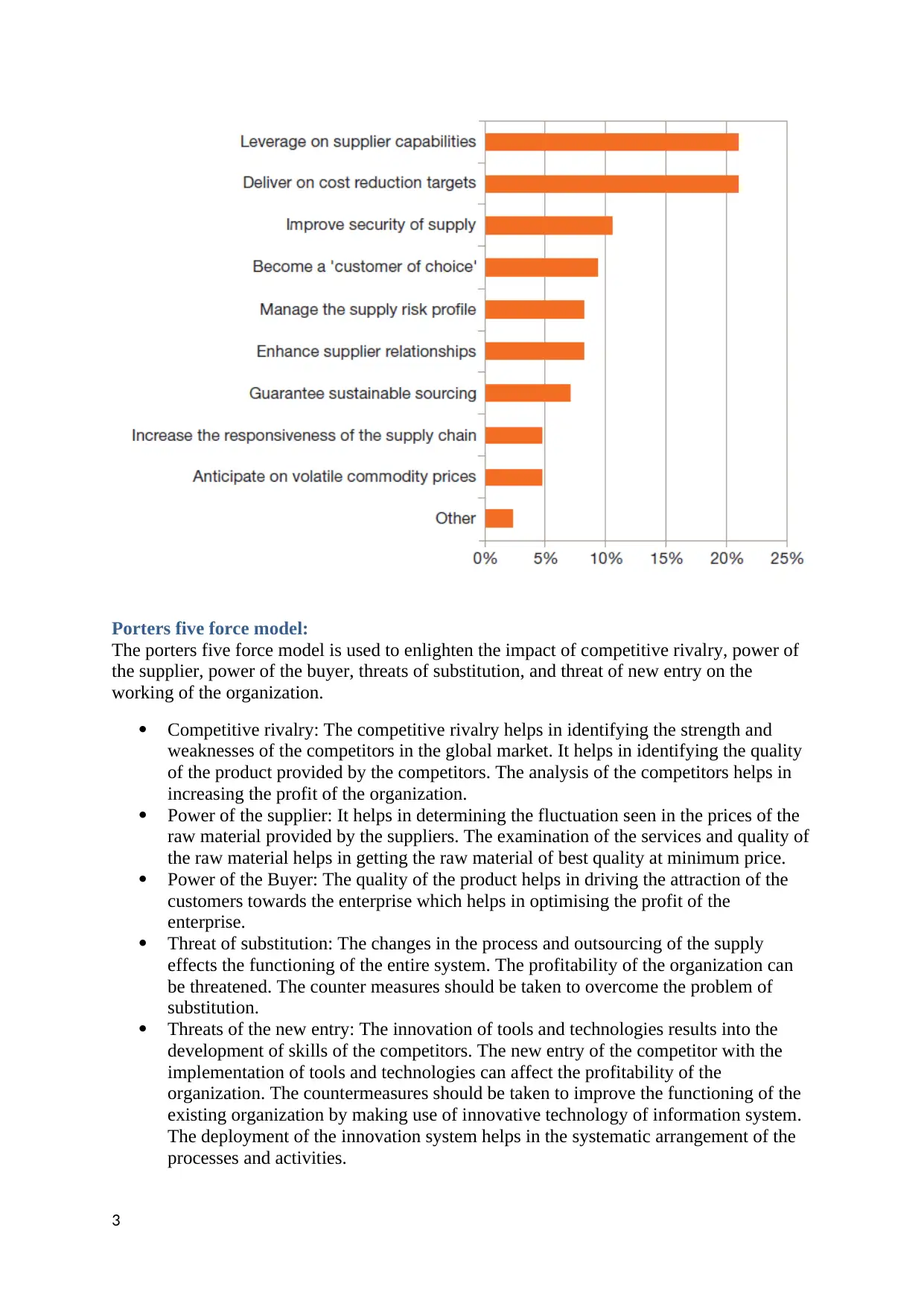
Porters five force model:
The porters five force model is used to enlighten the impact of competitive rivalry, power of
the supplier, power of the buyer, threats of substitution, and threat of new entry on the
working of the organization.
Competitive rivalry: The competitive rivalry helps in identifying the strength and
weaknesses of the competitors in the global market. It helps in identifying the quality
of the product provided by the competitors. The analysis of the competitors helps in
increasing the profit of the organization.
Power of the supplier: It helps in determining the fluctuation seen in the prices of the
raw material provided by the suppliers. The examination of the services and quality of
the raw material helps in getting the raw material of best quality at minimum price.
Power of the Buyer: The quality of the product helps in driving the attraction of the
customers towards the enterprise which helps in optimising the profit of the
enterprise.
Threat of substitution: The changes in the process and outsourcing of the supply
effects the functioning of the entire system. The profitability of the organization can
be threatened. The counter measures should be taken to overcome the problem of
substitution.
Threats of the new entry: The innovation of tools and technologies results into the
development of skills of the competitors. The new entry of the competitor with the
implementation of tools and technologies can affect the profitability of the
organization. The countermeasures should be taken to improve the functioning of the
existing organization by making use of innovative technology of information system.
The deployment of the innovation system helps in the systematic arrangement of the
processes and activities.
3
The porters five force model is used to enlighten the impact of competitive rivalry, power of
the supplier, power of the buyer, threats of substitution, and threat of new entry on the
working of the organization.
Competitive rivalry: The competitive rivalry helps in identifying the strength and
weaknesses of the competitors in the global market. It helps in identifying the quality
of the product provided by the competitors. The analysis of the competitors helps in
increasing the profit of the organization.
Power of the supplier: It helps in determining the fluctuation seen in the prices of the
raw material provided by the suppliers. The examination of the services and quality of
the raw material helps in getting the raw material of best quality at minimum price.
Power of the Buyer: The quality of the product helps in driving the attraction of the
customers towards the enterprise which helps in optimising the profit of the
enterprise.
Threat of substitution: The changes in the process and outsourcing of the supply
effects the functioning of the entire system. The profitability of the organization can
be threatened. The counter measures should be taken to overcome the problem of
substitution.
Threats of the new entry: The innovation of tools and technologies results into the
development of skills of the competitors. The new entry of the competitor with the
implementation of tools and technologies can affect the profitability of the
organization. The countermeasures should be taken to improve the functioning of the
existing organization by making use of innovative technology of information system.
The deployment of the innovation system helps in the systematic arrangement of the
processes and activities.
3
Paraphrase This Document
Need a fresh take? Get an instant paraphrase of this document with our AI Paraphraser
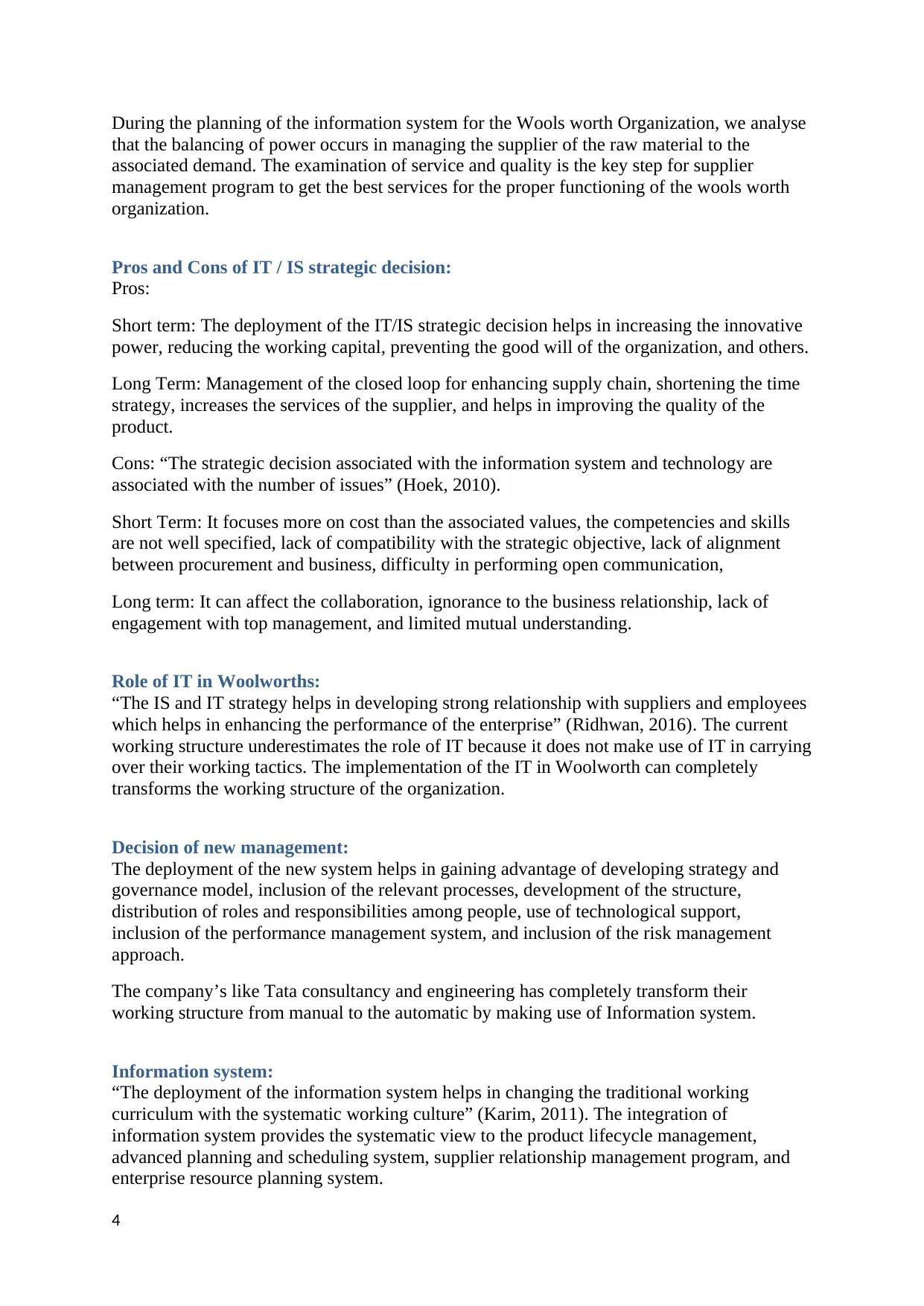
During the planning of the information system for the Wools worth Organization, we analyse
that the balancing of power occurs in managing the supplier of the raw material to the
associated demand. The examination of service and quality is the key step for supplier
management program to get the best services for the proper functioning of the wools worth
organization.
Pros and Cons of IT / IS strategic decision:
Pros:
Short term: The deployment of the IT/IS strategic decision helps in increasing the innovative
power, reducing the working capital, preventing the good will of the organization, and others.
Long Term: Management of the closed loop for enhancing supply chain, shortening the time
strategy, increases the services of the supplier, and helps in improving the quality of the
product.
Cons: “The strategic decision associated with the information system and technology are
associated with the number of issues” (Hoek, 2010).
Short Term: It focuses more on cost than the associated values, the competencies and skills
are not well specified, lack of compatibility with the strategic objective, lack of alignment
between procurement and business, difficulty in performing open communication,
Long term: It can affect the collaboration, ignorance to the business relationship, lack of
engagement with top management, and limited mutual understanding.
Role of IT in Woolworths:
“The IS and IT strategy helps in developing strong relationship with suppliers and employees
which helps in enhancing the performance of the enterprise” (Ridhwan, 2016). The current
working structure underestimates the role of IT because it does not make use of IT in carrying
over their working tactics. The implementation of the IT in Woolworth can completely
transforms the working structure of the organization.
Decision of new management:
The deployment of the new system helps in gaining advantage of developing strategy and
governance model, inclusion of the relevant processes, development of the structure,
distribution of roles and responsibilities among people, use of technological support,
inclusion of the performance management system, and inclusion of the risk management
approach.
The company’s like Tata consultancy and engineering has completely transform their
working structure from manual to the automatic by making use of Information system.
Information system:
“The deployment of the information system helps in changing the traditional working
curriculum with the systematic working culture” (Karim, 2011). The integration of
information system provides the systematic view to the product lifecycle management,
advanced planning and scheduling system, supplier relationship management program, and
enterprise resource planning system.
4
that the balancing of power occurs in managing the supplier of the raw material to the
associated demand. The examination of service and quality is the key step for supplier
management program to get the best services for the proper functioning of the wools worth
organization.
Pros and Cons of IT / IS strategic decision:
Pros:
Short term: The deployment of the IT/IS strategic decision helps in increasing the innovative
power, reducing the working capital, preventing the good will of the organization, and others.
Long Term: Management of the closed loop for enhancing supply chain, shortening the time
strategy, increases the services of the supplier, and helps in improving the quality of the
product.
Cons: “The strategic decision associated with the information system and technology are
associated with the number of issues” (Hoek, 2010).
Short Term: It focuses more on cost than the associated values, the competencies and skills
are not well specified, lack of compatibility with the strategic objective, lack of alignment
between procurement and business, difficulty in performing open communication,
Long term: It can affect the collaboration, ignorance to the business relationship, lack of
engagement with top management, and limited mutual understanding.
Role of IT in Woolworths:
“The IS and IT strategy helps in developing strong relationship with suppliers and employees
which helps in enhancing the performance of the enterprise” (Ridhwan, 2016). The current
working structure underestimates the role of IT because it does not make use of IT in carrying
over their working tactics. The implementation of the IT in Woolworth can completely
transforms the working structure of the organization.
Decision of new management:
The deployment of the new system helps in gaining advantage of developing strategy and
governance model, inclusion of the relevant processes, development of the structure,
distribution of roles and responsibilities among people, use of technological support,
inclusion of the performance management system, and inclusion of the risk management
approach.
The company’s like Tata consultancy and engineering has completely transform their
working structure from manual to the automatic by making use of Information system.
Information system:
“The deployment of the information system helps in changing the traditional working
curriculum with the systematic working culture” (Karim, 2011). The integration of
information system provides the systematic view to the product lifecycle management,
advanced planning and scheduling system, supplier relationship management program, and
enterprise resource planning system.
4
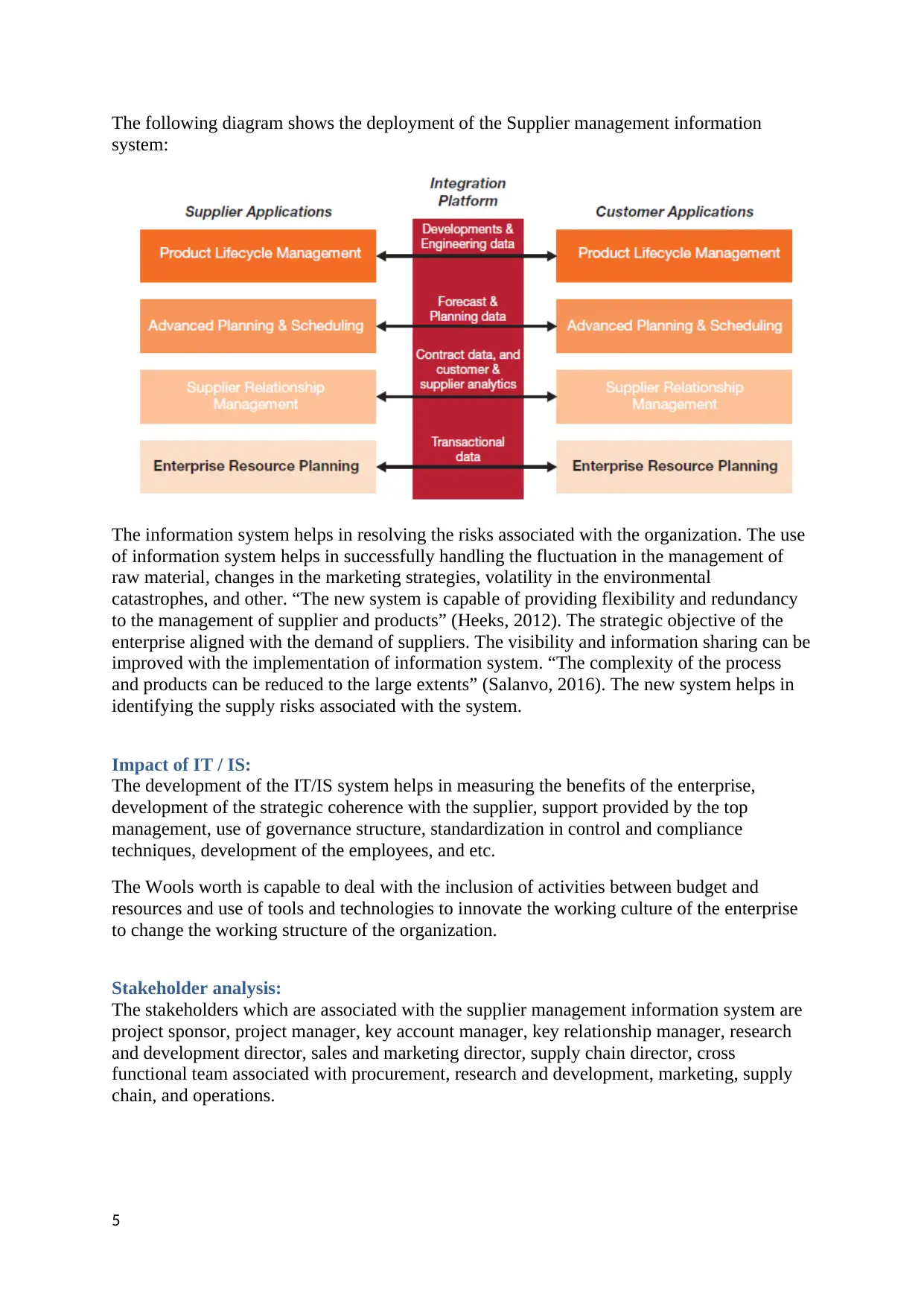
The following diagram shows the deployment of the Supplier management information
system:
The information system helps in resolving the risks associated with the organization. The use
of information system helps in successfully handling the fluctuation in the management of
raw material, changes in the marketing strategies, volatility in the environmental
catastrophes, and other. “The new system is capable of providing flexibility and redundancy
to the management of supplier and products” (Heeks, 2012). The strategic objective of the
enterprise aligned with the demand of suppliers. The visibility and information sharing can be
improved with the implementation of information system. “The complexity of the process
and products can be reduced to the large extents” (Salanvo, 2016). The new system helps in
identifying the supply risks associated with the system.
Impact of IT / IS:
The development of the IT/IS system helps in measuring the benefits of the enterprise,
development of the strategic coherence with the supplier, support provided by the top
management, use of governance structure, standardization in control and compliance
techniques, development of the employees, and etc.
The Wools worth is capable to deal with the inclusion of activities between budget and
resources and use of tools and technologies to innovate the working culture of the enterprise
to change the working structure of the organization.
Stakeholder analysis:
The stakeholders which are associated with the supplier management information system are
project sponsor, project manager, key account manager, key relationship manager, research
and development director, sales and marketing director, supply chain director, cross
functional team associated with procurement, research and development, marketing, supply
chain, and operations.
5
system:
The information system helps in resolving the risks associated with the organization. The use
of information system helps in successfully handling the fluctuation in the management of
raw material, changes in the marketing strategies, volatility in the environmental
catastrophes, and other. “The new system is capable of providing flexibility and redundancy
to the management of supplier and products” (Heeks, 2012). The strategic objective of the
enterprise aligned with the demand of suppliers. The visibility and information sharing can be
improved with the implementation of information system. “The complexity of the process
and products can be reduced to the large extents” (Salanvo, 2016). The new system helps in
identifying the supply risks associated with the system.
Impact of IT / IS:
The development of the IT/IS system helps in measuring the benefits of the enterprise,
development of the strategic coherence with the supplier, support provided by the top
management, use of governance structure, standardization in control and compliance
techniques, development of the employees, and etc.
The Wools worth is capable to deal with the inclusion of activities between budget and
resources and use of tools and technologies to innovate the working culture of the enterprise
to change the working structure of the organization.
Stakeholder analysis:
The stakeholders which are associated with the supplier management information system are
project sponsor, project manager, key account manager, key relationship manager, research
and development director, sales and marketing director, supply chain director, cross
functional team associated with procurement, research and development, marketing, supply
chain, and operations.
5
⊘ This is a preview!⊘
Do you want full access?
Subscribe today to unlock all pages.

Trusted by 1+ million students worldwide
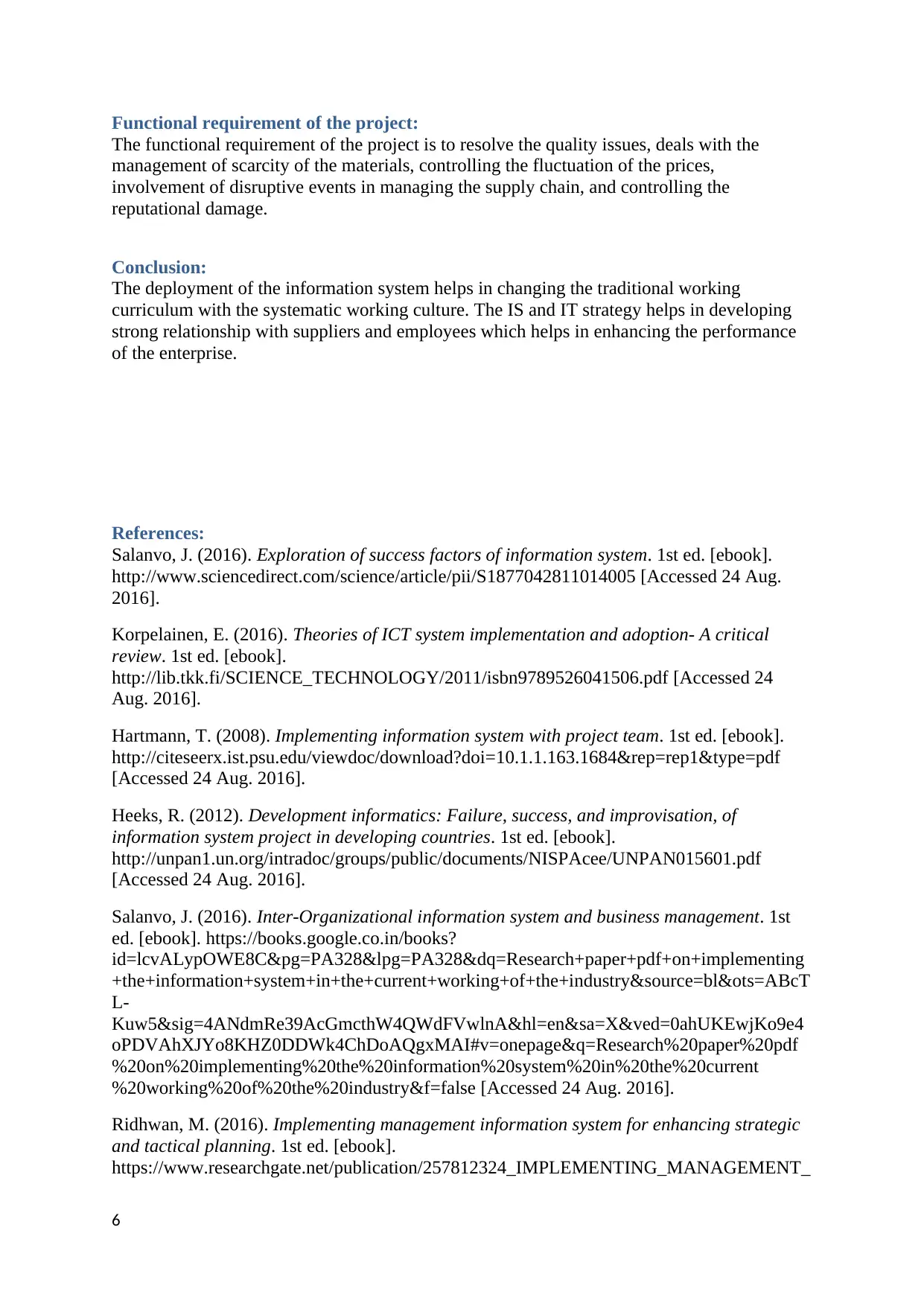
Functional requirement of the project:
The functional requirement of the project is to resolve the quality issues, deals with the
management of scarcity of the materials, controlling the fluctuation of the prices,
involvement of disruptive events in managing the supply chain, and controlling the
reputational damage.
Conclusion:
The deployment of the information system helps in changing the traditional working
curriculum with the systematic working culture. The IS and IT strategy helps in developing
strong relationship with suppliers and employees which helps in enhancing the performance
of the enterprise.
References:
Salanvo, J. (2016). Exploration of success factors of information system. 1st ed. [ebook].
http://www.sciencedirect.com/science/article/pii/S1877042811014005 [Accessed 24 Aug.
2016].
Korpelainen, E. (2016). Theories of ICT system implementation and adoption- A critical
review. 1st ed. [ebook].
http://lib.tkk.fi/SCIENCE_TECHNOLOGY/2011/isbn9789526041506.pdf [Accessed 24
Aug. 2016].
Hartmann, T. (2008). Implementing information system with project team. 1st ed. [ebook].
http://citeseerx.ist.psu.edu/viewdoc/download?doi=10.1.1.163.1684&rep=rep1&type=pdf
[Accessed 24 Aug. 2016].
Heeks, R. (2012). Development informatics: Failure, success, and improvisation, of
information system project in developing countries. 1st ed. [ebook].
http://unpan1.un.org/intradoc/groups/public/documents/NISPAcee/UNPAN015601.pdf
[Accessed 24 Aug. 2016].
Salanvo, J. (2016). Inter-Organizational information system and business management. 1st
ed. [ebook]. https://books.google.co.in/books?
id=lcvALypOWE8C&pg=PA328&lpg=PA328&dq=Research+paper+pdf+on+implementing
+the+information+system+in+the+current+working+of+the+industry&source=bl&ots=ABcT
L-
Kuw5&sig=4ANdmRe39AcGmcthW4QWdFVwlnA&hl=en&sa=X&ved=0ahUKEwjKo9e4
oPDVAhXJYo8KHZ0DDWk4ChDoAQgxMAI#v=onepage&q=Research%20paper%20pdf
%20on%20implementing%20the%20information%20system%20in%20the%20current
%20working%20of%20the%20industry&f=false [Accessed 24 Aug. 2016].
Ridhwan, M. (2016). Implementing management information system for enhancing strategic
and tactical planning. 1st ed. [ebook].
https://www.researchgate.net/publication/257812324_IMPLEMENTING_MANAGEMENT_
6
The functional requirement of the project is to resolve the quality issues, deals with the
management of scarcity of the materials, controlling the fluctuation of the prices,
involvement of disruptive events in managing the supply chain, and controlling the
reputational damage.
Conclusion:
The deployment of the information system helps in changing the traditional working
curriculum with the systematic working culture. The IS and IT strategy helps in developing
strong relationship with suppliers and employees which helps in enhancing the performance
of the enterprise.
References:
Salanvo, J. (2016). Exploration of success factors of information system. 1st ed. [ebook].
http://www.sciencedirect.com/science/article/pii/S1877042811014005 [Accessed 24 Aug.
2016].
Korpelainen, E. (2016). Theories of ICT system implementation and adoption- A critical
review. 1st ed. [ebook].
http://lib.tkk.fi/SCIENCE_TECHNOLOGY/2011/isbn9789526041506.pdf [Accessed 24
Aug. 2016].
Hartmann, T. (2008). Implementing information system with project team. 1st ed. [ebook].
http://citeseerx.ist.psu.edu/viewdoc/download?doi=10.1.1.163.1684&rep=rep1&type=pdf
[Accessed 24 Aug. 2016].
Heeks, R. (2012). Development informatics: Failure, success, and improvisation, of
information system project in developing countries. 1st ed. [ebook].
http://unpan1.un.org/intradoc/groups/public/documents/NISPAcee/UNPAN015601.pdf
[Accessed 24 Aug. 2016].
Salanvo, J. (2016). Inter-Organizational information system and business management. 1st
ed. [ebook]. https://books.google.co.in/books?
id=lcvALypOWE8C&pg=PA328&lpg=PA328&dq=Research+paper+pdf+on+implementing
+the+information+system+in+the+current+working+of+the+industry&source=bl&ots=ABcT
L-
Kuw5&sig=4ANdmRe39AcGmcthW4QWdFVwlnA&hl=en&sa=X&ved=0ahUKEwjKo9e4
oPDVAhXJYo8KHZ0DDWk4ChDoAQgxMAI#v=onepage&q=Research%20paper%20pdf
%20on%20implementing%20the%20information%20system%20in%20the%20current
%20working%20of%20the%20industry&f=false [Accessed 24 Aug. 2016].
Ridhwan, M. (2016). Implementing management information system for enhancing strategic
and tactical planning. 1st ed. [ebook].
https://www.researchgate.net/publication/257812324_IMPLEMENTING_MANAGEMENT_
6
Paraphrase This Document
Need a fresh take? Get an instant paraphrase of this document with our AI Paraphraser
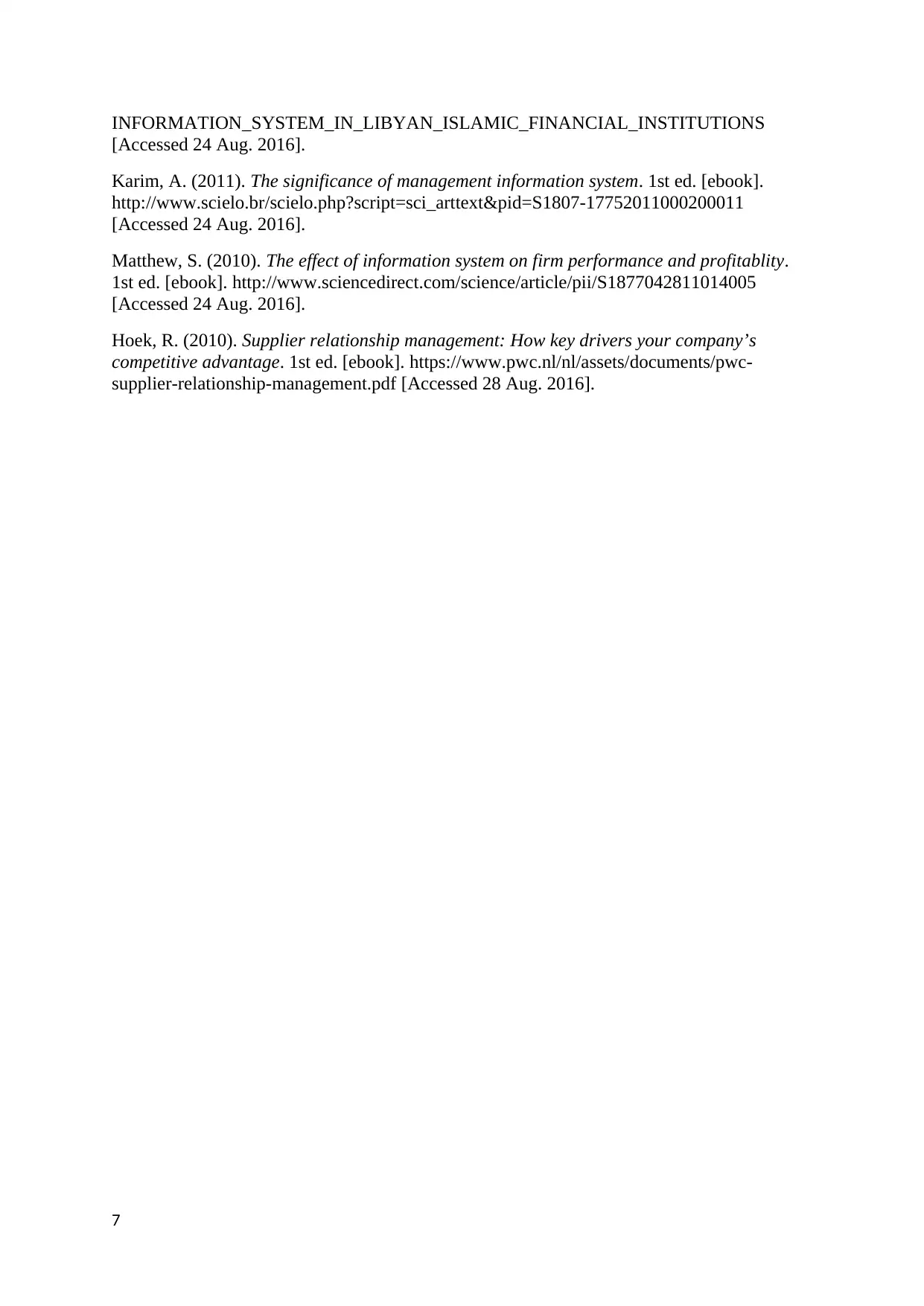
INFORMATION_SYSTEM_IN_LIBYAN_ISLAMIC_FINANCIAL_INSTITUTIONS
[Accessed 24 Aug. 2016].
Karim, A. (2011). The significance of management information system. 1st ed. [ebook].
http://www.scielo.br/scielo.php?script=sci_arttext&pid=S1807-17752011000200011
[Accessed 24 Aug. 2016].
Matthew, S. (2010). The effect of information system on firm performance and profitablity.
1st ed. [ebook]. http://www.sciencedirect.com/science/article/pii/S1877042811014005
[Accessed 24 Aug. 2016].
Hoek, R. (2010). Supplier relationship management: How key drivers your company’s
competitive advantage. 1st ed. [ebook]. https://www.pwc.nl/nl/assets/documents/pwc-
supplier-relationship-management.pdf [Accessed 28 Aug. 2016].
7
[Accessed 24 Aug. 2016].
Karim, A. (2011). The significance of management information system. 1st ed. [ebook].
http://www.scielo.br/scielo.php?script=sci_arttext&pid=S1807-17752011000200011
[Accessed 24 Aug. 2016].
Matthew, S. (2010). The effect of information system on firm performance and profitablity.
1st ed. [ebook]. http://www.sciencedirect.com/science/article/pii/S1877042811014005
[Accessed 24 Aug. 2016].
Hoek, R. (2010). Supplier relationship management: How key drivers your company’s
competitive advantage. 1st ed. [ebook]. https://www.pwc.nl/nl/assets/documents/pwc-
supplier-relationship-management.pdf [Accessed 28 Aug. 2016].
7
1 out of 8
Related Documents
Your All-in-One AI-Powered Toolkit for Academic Success.
+13062052269
info@desklib.com
Available 24*7 on WhatsApp / Email
![[object Object]](/_next/static/media/star-bottom.7253800d.svg)
Unlock your academic potential
Copyright © 2020–2025 A2Z Services. All Rights Reserved. Developed and managed by ZUCOL.





